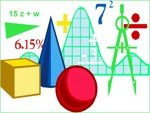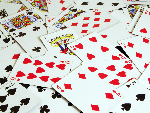Published on Friday, September 13, 2013 in
calendar,
fun,
math,
videos
 Instead of posting on Thursday, I thought I'd wait until today, so we can enjoy some Friday the 13th fun!
Instead of posting on Thursday, I thought I'd wait until today, so we can enjoy some Friday the 13th fun!
Do I believe in the superstitions about Friday the 13th? No. Without them, however, Friday the 13th is just another day, so they do serve at least one good purpose!
Let's start off with a nod to those superstitions, then, including why even the non-superstitious may need to take them seriously:
How long until the next year without a Friday the 13th? Well, if you look at a calendar, the only time a Friday the 13th can occur is when the 1st of the month falls on a Sunday. Let's take a close look at when each month begins.
January 1st can, of course, fall on any day of the week. We'll refer to this uknown day as d. Now, regardless of which day d is, the first of February happens 31 days later. More accurately, it happens 4 weeks and 3 days later. So, whichever day of the week d is, February will begin 3 days of the week later. Working through the individual months in this way, here's what we find for a non-leap year:
January begins on day d.
February begins on day d + 3.
March begins on day d + 3.
April begins on day d + 6.
May begins on day d + 1.
June begins on day d + 4.
July begins on day d + 6.
August begins on day d + 2.
September begins on day d + 5.
Stop at this point and notice an important feature here. We have months than begin on d, d + 1, d + 2, d + 3, d + 4, d + 5, and d + 6. So, by September of a non-leap year, we must have a month that began on a Sunday. That, in turn means at least one of those months must have a Friday the 13th!
Is this also true for leap years? Let's work through a month of leap years in the same way and find out:
January begins on day d.
February begins on day d + 3.
March begins on day d + 4.
April begins on day d.
May begins on day d + 2.
June begins on day d + 5.
July begins on day d.
August begins on day d + 3.
September begins on day d + 6.
October begins on day d + 1.
In a leap year, it takes until October to guarantee that a month will begin with a Sunday, and therefore to guarantee that a month will have a Friday the 13th.
In other words, if you're waiting for a year without a Friday the 13th, it's not going to happen without another major calendar reform.
Now, as many Grey Matters regulars already know, the Gregorian calendar (the one most people currently use) repeats itself exactly every 400 years. So, September 13, 2413 will also be a Friday the 13th!
Out of curiosity, what is the most common day of the week on which the 13th falls? Over at QED Cat, they took the time to examine all 4800 months, and found that the 13th is more likely to fall on a Friday than any other day! Thursday and Saturday are the least common days, occuring only 684 times each out of 4800 months, while Friday occurs 688 times every 4800 months! Granted, this is only a difference of about 14.25% versus about 14.3%, so it's not like Friday occurs wildly out of proportion to the other days.
I wrap this post up with one final thought. 2013 has 2 + 0 13ths on a Friday. The next one will be in December, exactly 13 weeks from today!

 If you've read even a little of this blog, you know I love playing with math.
If you've read even a little of this blog, you know I love playing with math.









